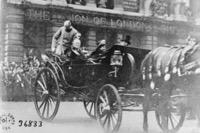
President Woodrow Wilson was given the freedom of the City of Manchester at the turn of the year when he visited the North West. He had an affection for the Lakes and Carlisle and wished to visit the church where his grandfather had preached. He spoke at the Free Trade Hall and went to the offices of the Manchester Guardian before moving on to Versailles and the Peace Conference.
Remembrance was now paramount to convince the British public that their sacrifice had not been in vain. The battlefields were being painstakingly cleared of munitions and bodies. The Imperial War Graves Commission founded in 1917 by Fabian Ware (it became the CWGC in 1960) began the monumental task of burial and commemoration. All our cemeteries abroad followed the same design and aesthetic if geographical conditions allowed. In gardens designed by Gertrude Jekyll and surrounded by a low wall, the graveyards contain an entrance, often a cross or stone of sacrifice and rows of headstones made of Portland stone in uniform plots. Each one is 30" tall, 15" wide and 3" thick containing the national emblem or regimental badge, rank, name, date of death and age of each fatality. More affluent families could pay for additional phrases. If a body could not be identified, Kipling's words "A soldier of the Great War known unto God" were inscribed. All headstones are the same size irrespective of rank and in 1914 it was decided there was to be no repatriation of bodies.
WWI servicemen who died between 4th August 1914 and 31st August 1921 are all remembered by the CWGC. We had 12 in the period 1919 to 1921.
Driver Richard Whalley Hamnett died on 5th January 1919, aged 23. He had served with the RASC (TR2/015946). He had been apprenticed to a mechanical engineer before the war. Richard is buried in St Bart's and remembered there, at the civic memorial and in Wilmslow Methodist Church.
Private Wallace Slater, Croix de Guerre of the 1st/7th Cheshires (290747) died, aged 28, on 17th February 1919 in the 48th Casualty Clearing Station. He had been apprenticed to a boot maker and lived at 35 Brook Lane. Wallace is buried at the Belgrade Cemetery, Namur and commemorated in Alderley Edge and at St John's.
St John's Lindow and Alderley Edge memorial also commemorate Private Percy Burgess of the 8th Cheshires (53750) who died on 9th March 1919 of pleurisy in Manchester before he could be demobbed. He was only 19 and had spent time as a PoW in Germany. He lived with his widowed mother at 65 Brook Lane and was a farm labourer before joining up in January 1917. He is buried in St John's graveyard.
Captain Arthur Rushton Bickham died, aged 33, at "Lyndhurst", Altrincham on 15th February 1919. Before the war he lived at "Hill View", Alderley and worked for his father, an East India merchant. Arthur was educated at Ryleys, Malvern and Manchester University. He died of septic pneumonia contracted in Italy serving with the Royal Garrison Artillery 155th Heavy Brigade and was mentioned in dispatches by Plumer. He is buried at St John's where he is also remembered. His name is on the Wilmslow civic memorial as well.
Basra War Cemetery is the last resting place of Captain Hubert Burrington Thornhill of the 1st Devons (attached later to the Royal West Kents) who died of diphtheria, aged 24, on 23rd March 1919. His connection with the community is unclear. Before the war he was living with his wife, Dorothy, at Cumnor Hill, Oxford, but he did spend time in Winsford Hospital in 1915 with a serious leg injury. St Bart's and the civic memorial record his passing.
Private Albert Victor Brace died, aged 32, on 2nd April 1919. Before the war he had been a domestic gardener. He joined the RAMC (85637) in April 1915 as an ambulance driver. Albert was discharged in January 1917 with TB and breathing problems and last worked in the canteen at the Handforth PoW camp. He is buried at St Chad's, Handforth and remembered locally
Wilmslow Cemetery is the last resting place of Private George Slater of the 2nd Royal Welsh Fusiliers (8643) (Labour Corps). He died at home, aged 32, on 10th May 1919. He was a professional soldier serving in India in 1911 and before that worked as a cotton textile printer. St Bart's and the civic memorial mark his passing.
H (perhaps Harold) Bower died on 11th January 1920. In 1911 he was a resident of Hawthorne Street. He served with the Royal Welsh Fusiliers (238058) and is buried in Wilmslow Cemetery. No other details are yet to hand.
The other 1920 fatality was Private John Reade of the 2nd Manchesters (52940 ex 3512884). He died, aged 20, on the 27th January. He was the son of Peter (a cattle dealer) and Hannah of Stanley Terrace, Knutsford Road, Lindow. John is buried in Basra and listed at St John's, the civic memorial and Basra.
Private David Turner Broadhurst of the 1st Cheshires Labour Corps (56949) died, aged 40, on 9th May 1921. He was born in Wilmslow and had lived with his wife, Margaret, at Laburnum Cottage. His family were in Alma Lane. David had been a house painter. He is buried in Wilmslow Cemetery.
Sapper Harry J Kinsey also died aged 40. He was the husband of Margaret of Bollin Walk. Harry served with the Royal Engineers (237214) and died on 15th May 1921. He is buried in Wilmslow Cemetery.
Private John Acton of the 3rd Cheshires (34999) was also buried in Wilmslow Cemetery having died on 25th May 1921, aged 29. Before the war he lived at Bant House Farm Morley and had been a milkman. He is remembered on the Morley memorial.
Apologies are offered to the memory of John Hewitt, Private in the 7th South Lancs (26945), who was sadly omitted from our record of the fallen at Passchendaele. He was wounded on the first day of the attack and died, aged 25, a day later on 1st August 1917. John is buried at Bailleul Communal Cemetery Extension and is remembered at St Bart's and on the civic memorial. He was the son of Reuben and Elizabeth and lived at Ladyfield Street. Before the war he worked at Berry Corn Mills.
This is the last of 55 monthly articles. We have tried to record the valour and resilience of the 287 young men from Wilmslow and surrounding villages, who perished during and just after the Great War. The conflict had huge geopolitical consequences and a lasting effect on the societies that sent their boys to fight. Its impact is still keenly felt. Above all, we must never forget:
"At the going down of the sun and in the morning
We will remember them"
Jon Armstrong and Alan Cooper with a contribution from Michael Scaife
Wilmslow Historical Society also Geoff Butt.
Photo: President Wilson in Manchester.
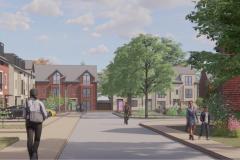
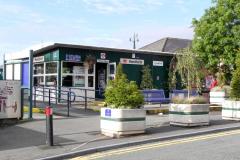



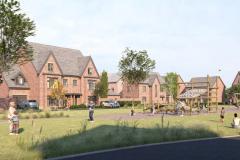
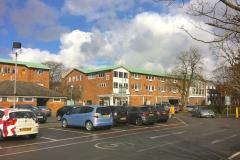
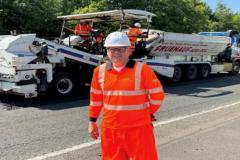
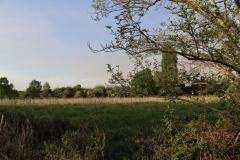

Comments
Here's what readers have had to say so far. Why not add your thoughts below.
Thank you.
Lest we forget.